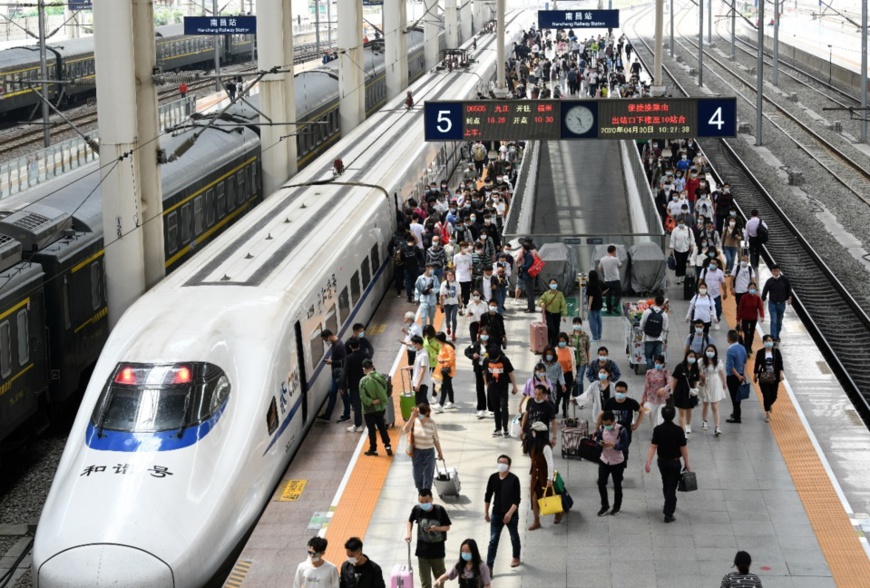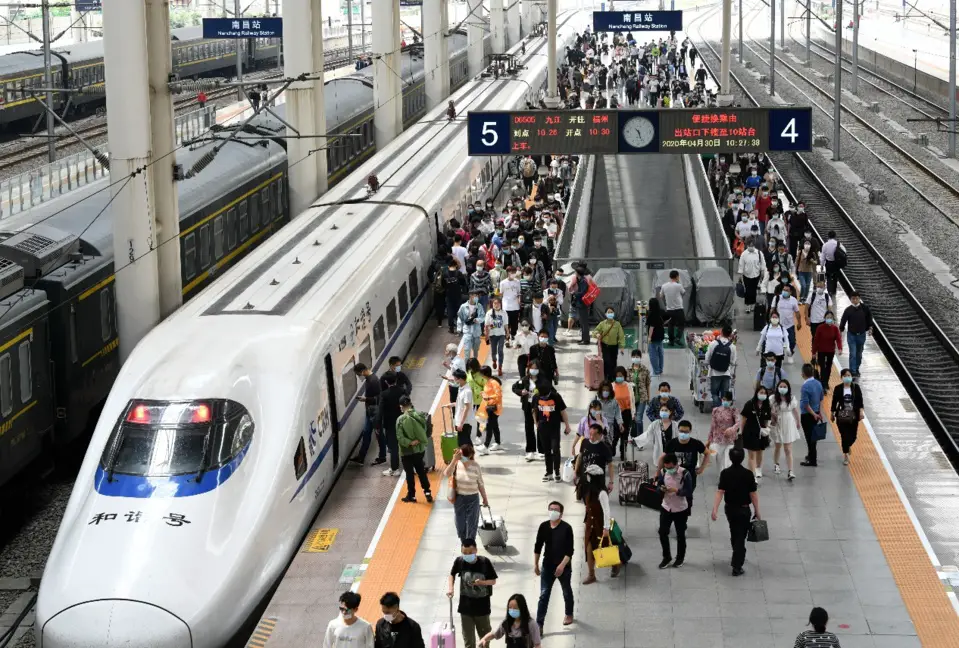By Lu Ya’nan, Cheng Shijie, People’s Daily

Passengers take bullet trains at Nanchang Railway Station, east China’s Jiangxi province, April 30. Photo by Hu Guolin, People’s Daily Online
Qu Chuncai, a woman living in Fangcheng county, Nanyang of central China’s Henan province is taking a selfie in front of a newly-built high-speed railway station in the county, holding her three-year-old child with one arm.
It’s not the first time for her to visit the train station. “I came here since the project commenced, just to share the construction progress with my husband,” the woman said, who can’t hide her joy when speaking of the grand facility in her hometown.
Qu’s husband Song Hongquan is a businessman working in Wuhan, central China’s Hubei province. He earns much from his inkstone business, but to go home was always a tough journey.
Qu told People’s Daily that her husband had to take a 6-hour train from Wuhan to Nanyang, and then spend about a quarter walking to Nanyang’s bus station. Another two hours at least were needed before he finally took a bus home in Fangcheng county.
Thanks to the opening of the Zhengzhou-Xiangyang section on the Zhengzhou-Chongqing high-speed railway last December, the time needed to travel from Fangcheng to Wuhan was reduced to 3 hours from 8. “He can now enjoy Wuhan hot-dry noodles for breakfast in Wuhan and then come home for a bowl of stewed noodle (a specialty of Henan province) at noon,” Qu said.
China’s high-speed rail construction is benefiting millions of people. Transport Minister Li Xiaopeng introduced on a May 19 press conference held by the State Council Information Office that a total of 3.2451 trillion yuan of fixed assets investment was made in the transport sector last year, with world-class projects such as the Beijing Daxing International Airport and Beijing-Zhangjiakou high-speed railway starting operation. According to Li, China’s railway network spans over 139,000 kilometers, including 35,000 kilometers of high-speed rail.
The total mileage of China’s railway network is expected to hit 146,000 kilometers by the end of this year, reaching 99 percent of the cities with a population of no less than 200,000. The high-speed rail mileage will reach 39,000 kilometers, and China will still remain the world’s largest operator of high-speed railway.
High-speed rails are changing people’s lives, turning their expectations into reality.
“The high-speed railway is just making it so convenient,” said Xu Li, who always commutes between Beijing and Hohhot, capital of Inner Mongolia Autonomous Region to see doctors. The man can now go to Beijing in the morning after making online appointments and return to Hohhot on the same day. The Beijing-Zhangjiakou and Zhangjiakou-Hohhot high-speed railways have reduced the travel time between Hohhot and Beijing to 2 hours and 18 minutes from the previous 9 hours.
Yimeng, a mountainous area in east China’s Shandong province, is known for its local specialties and fertile environment. A planned cargo high-speed rail express is now turning the poor transportation in the region a thing in the past.
Niu Qinghua, who runs e-commerce agricultural business in Yimeng, said that the high-speed cargo service, if used to transport peaches in Yimeng, will not only lower the cost, but also present better taste of the fruits, as the peaches can be picked when they are completely mature.
Xingguo county in east China’s Jiangxi province was one of the impoverished regions connected to the high-speed rail network last year.
“Not many people ran factories in my hometown as the transportation was poor, but now I must expand my factory because of the high-speed rail,” said Liu Yanming, head of a garment factory in the county which employs 60 workers. Besides, 11 impoverished people now work at the factory’s poverty-alleviation workshop.
“I had three business trips per month at most before as it took at least a day to go to Shanghai and Guangzhou. When the Nanchang-Ganzhou high-speed railway opens, it will only take a couple of hours to get to Guangzhou, so I’ll go whenever I want,” Liu noted, adding that more business trips will surely make his business better, and thus helping his fellow villagers pursue a better-off life.
It’s not the first time for her to visit the train station. “I came here since the project commenced, just to share the construction progress with my husband,” the woman said, who can’t hide her joy when speaking of the grand facility in her hometown.
Qu’s husband Song Hongquan is a businessman working in Wuhan, central China’s Hubei province. He earns much from his inkstone business, but to go home was always a tough journey.
Qu told People’s Daily that her husband had to take a 6-hour train from Wuhan to Nanyang, and then spend about a quarter walking to Nanyang’s bus station. Another two hours at least were needed before he finally took a bus home in Fangcheng county.
Thanks to the opening of the Zhengzhou-Xiangyang section on the Zhengzhou-Chongqing high-speed railway last December, the time needed to travel from Fangcheng to Wuhan was reduced to 3 hours from 8. “He can now enjoy Wuhan hot-dry noodles for breakfast in Wuhan and then come home for a bowl of stewed noodle (a specialty of Henan province) at noon,” Qu said.
China’s high-speed rail construction is benefiting millions of people. Transport Minister Li Xiaopeng introduced on a May 19 press conference held by the State Council Information Office that a total of 3.2451 trillion yuan of fixed assets investment was made in the transport sector last year, with world-class projects such as the Beijing Daxing International Airport and Beijing-Zhangjiakou high-speed railway starting operation. According to Li, China’s railway network spans over 139,000 kilometers, including 35,000 kilometers of high-speed rail.
The total mileage of China’s railway network is expected to hit 146,000 kilometers by the end of this year, reaching 99 percent of the cities with a population of no less than 200,000. The high-speed rail mileage will reach 39,000 kilometers, and China will still remain the world’s largest operator of high-speed railway.
High-speed rails are changing people’s lives, turning their expectations into reality.
“The high-speed railway is just making it so convenient,” said Xu Li, who always commutes between Beijing and Hohhot, capital of Inner Mongolia Autonomous Region to see doctors. The man can now go to Beijing in the morning after making online appointments and return to Hohhot on the same day. The Beijing-Zhangjiakou and Zhangjiakou-Hohhot high-speed railways have reduced the travel time between Hohhot and Beijing to 2 hours and 18 minutes from the previous 9 hours.
Yimeng, a mountainous area in east China’s Shandong province, is known for its local specialties and fertile environment. A planned cargo high-speed rail express is now turning the poor transportation in the region a thing in the past.
Niu Qinghua, who runs e-commerce agricultural business in Yimeng, said that the high-speed cargo service, if used to transport peaches in Yimeng, will not only lower the cost, but also present better taste of the fruits, as the peaches can be picked when they are completely mature.
Xingguo county in east China’s Jiangxi province was one of the impoverished regions connected to the high-speed rail network last year.
“Not many people ran factories in my hometown as the transportation was poor, but now I must expand my factory because of the high-speed rail,” said Liu Yanming, head of a garment factory in the county which employs 60 workers. Besides, 11 impoverished people now work at the factory’s poverty-alleviation workshop.
“I had three business trips per month at most before as it took at least a day to go to Shanghai and Guangzhou. When the Nanchang-Ganzhou high-speed railway opens, it will only take a couple of hours to get to Guangzhou, so I’ll go whenever I want,” Liu noted, adding that more business trips will surely make his business better, and thus helping his fellow villagers pursue a better-off life.
 Menu
Menu
 China’s total high-speed railway mileage to reach 39,000 kilometers by year end
China’s total high-speed railway mileage to reach 39,000 kilometers by year end
















